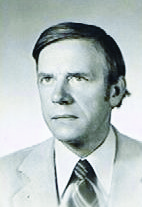Title of the work
Country of the First Edition
Country/countries of popularity
Original Language
First Edition Date
First Edition Details
Franciszek Kobryńczuk, “Jak Apollo zamienił w sroki córki Pierosa”, Biuletyn Północno-Wschodniej Izby Lekarsko-Weterynaryjnej [Bulletin of the North-Eastern Veterinary Chamber] 57.3 (2015): 100–101 (accessed: September 13, 2022).
ISBN
Available Onllne
Bulletin of the North-Eastern Veterinary Chamber 57.3 (2015): 100–101 (accessed: December 6, 2022).
Genre
Narrative poetry
Poetry
Target Audience
Children
Cover

We are still trying to obtain permission for posting the original cover.
Author of the Entry:
Maciej Skowera, University of Warsaw, mgskowera@uw.edu.pl
Peer-reviewer of the Entry:
Elżbieta Olechowska, University of Warsaw, elzbieta.olechowska@gmail.com
Katarzyna Marciniak, University of Warsaw, kamar@al.uw.edu.pl

Photograph courtesy of the Author.
Franciszek Kobryńczuk
, 1929 - 2016
(Author)
A veterinarian, professor of veterinary sciences specializing in animal anatomy (an authority on the anatomy of the Polish bison), writer, and poet. 1948–1950: a member of a secret youth organization active within the post-WW2 underground connected to Armia Krajowa [Home Army], banned by the Communist regime; in 1950 he was sentenced to a 10-year prison term for this activity; fully exonerated after the fall of Communism. Graduated from the Faculty of Veterinary Medicine of the Warsaw University of Life Sciences (SGGW); from 1994 to 2000 Head of the Department of Animal Anatomy at the same University. Debuted as an author for children in 1958 with a short poem Sowa [Owl], published in children’s magazine “Miś”; contributor to several other magazines for children and young adults, such as “Świerszczyk,” “Płomyk,” “Płomyczek,” and “Mały Apostoł”; author of about 30 books for children, young adults and adults; a former member of the Polish Writers’ Union; now his poems can be found most of all online. The page ewa.bicom.pl/wierszedzieci run by a Kobryńczuk’s admirer, Ewa Białek, functions as the official website for Kobryńczuk’s poems for children.
Source:
Materials kindly provided by the Author.
Bio prepared by Maciej Skowera, University of Warsaw, mgskowera@gmail.com
Summary
Apollo, the god of beauty, is also the guardian of the nine Muses, for whom he cares deeply. Pierus, the king of Macedonia and father to nine daughters, states they could take the place of the Muses and be better. Apollo immediately turns Pierus’ daughters into magpies when he hears this boast. In the ending, the lyrical I says that he hears magpies outside his house every day at dawn and believes they are the counterparts of Clio and Erato because they bring him facts and rhymes.
Analysis
The first part of the poem describes Apollo and the nine Muses, hinting at the areas they were responsible for. In the second part, we meet Pierus and learn about the fate that befell his daughters (the musical contest, present in the mythological accounts, is not mentioned). Franciszek Kobryńczuk writes about the metamorphosis of humans into animals – which is one of his favourite topics – being a divine punishment. In this work, attention is drawn to the last stanza, in which the lyrical I is revealed, telling how magpies/Muses help him write poems. Thus, the work contains a derivation from the classical tradition addressing the Muses directly as patronesses of artists and transmitters of inspiration.
Further Reading
Nosek, Anna, W przestrzeniach universum i regio. Wiersze dla dzieci współczesnych pisarzy regionu podlaskiego – interpretacje [In the Spaces of universum and regio: Poems for Children by Contemporary Writers of the Podlasie Region – Interpretations], Białystok: Wydawnictwo Uniwersytetu w Białymstoku, 2015.


